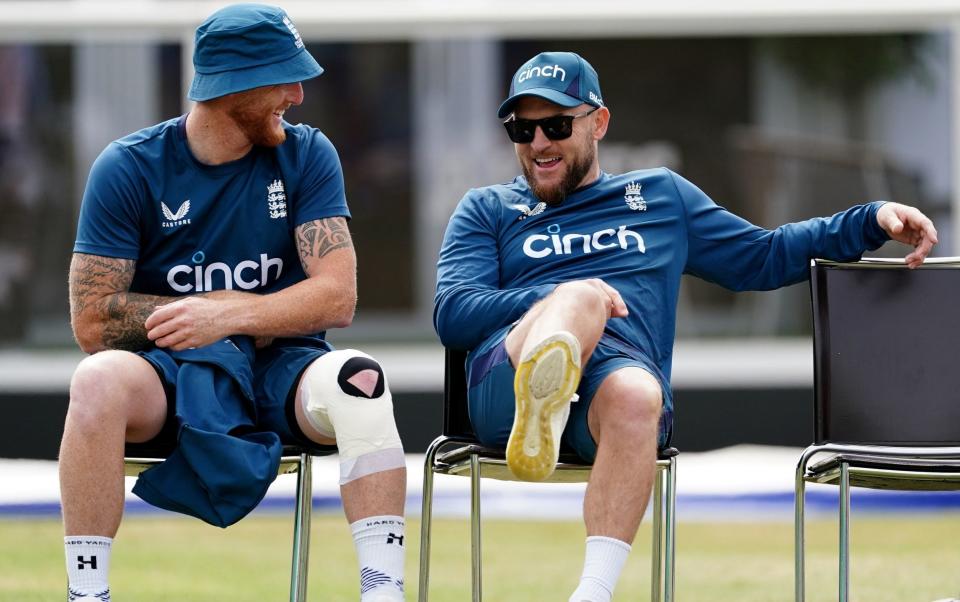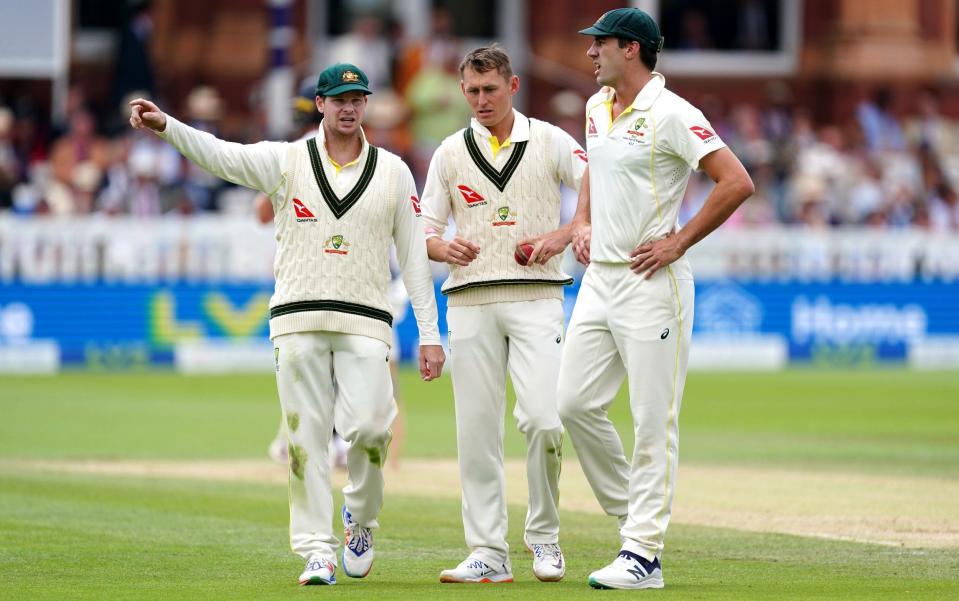
There’s a thesis to be written by someone on the role of smiles in cricket. In the famous Ashes match at Headingley in 1981, Ian Botham was just starting to play his shots early in his second innings after England had been forced to follow on but then failed to connect with a wild tilt at a ball from Dennis Lillee.
The all-rounder nervously glanced up at the players’ balcony, only to see a wide grin beaming back at him. Mike Brearley explains in The Art of Captaincy that he was trying to convey “my pleasure at his uninhibited approach and an unqualified approval for his continuing in that extravagant vein”. Botham went on to score a barnstorming 149 not out and give England just enough of a lead that the bowlers, led by Bob Willis, could skittle Australia out for 111 and win the game by 18 runs.
If an “uninhibited approach” sounds quite, well, Bazbally, there are also clear parallels in the captaincy of Brearley and Ben Stokes – including knowing when to flash their teeth. Last week, the Somerset spinner Jack Leach told Telegraph Sport’s Vaughany and Tuffers Cricket Club Podcast how Stokes is constantly persuading him that “my ceiling is higher than I realised”.
If the batsman is going after him, Leach might ask for the mid-off to be pushed back. Stokes, preferring the attacking option, will more often than not say no. But then, if the spinner gets whacked over the top, he’ll look around to see his skipper “clapping and clapping, with a big smile on his face”.
The results speak for themselves. At the Gabba in Brisbane in Dec 2021, Leach was smashed for 102 off 13 overs, giving him an economy rate of 7.84 – the sixth worst spanking in Test history. Last year he took 46 Test wickets, the third most of any bowler behind only South Africa’s Kagiso Rabada and Australia’s Nathan Lyon, who each picked up just one more.
Leach is the England team in microcosm. With more or less the same group of players that managed just one win in 17 matches, Brendon McCullum and Stokes then chalked up 10 wins in 11 outings, losing the 12th against New Zealand by a single run. It is the closest you will get to a control experiment in the importance of leadership outside of laboratory conditions. And the world beyond the boundary is taking notice.

“The Stokes captaincy will be a leadership case study for the years to come,” says Steve Wilkinson, the UK vice chair of EY who has worked with business leaders and top sports coaches. “It is going to be fascinating to see his approach broken down and analysed.”
In his latest book Turning Over Pebbles, Brearley, who became a psychoanalyst and psychotherapist after hanging up his batting gloves, hints at the lessons sport can teach the corporate world and vice versa when writing about the two main features of captaincy: “One to do with tactics and strategy, the other to do with human relations.”
He adds: “The latter calls for personal qualities of empathy, truthfulness and courage.”
Later in the book, Brearley quotes a passage in War and Peace where Tolstoy describes how the Russian general Mikhail Kutuzov “knew that the crucial element in war was ‘that intangible force, the spirit of the army’, so ‘he kept his eye on that force and guided it as far as lay within his power.’”
There’s lots that separates Brearley and Stokes – not least their eras and cricketing abilities but more obviously their academic background (a first in classics from Cambridge versus a solitary GCSE in PE). However, both are accomplished captains who turned losing sides into winners by getting the best out of talented individuals and harnessing the power of the collective. Stokes tends to downplay his intelligence but he’s no dummy. The former England analyst Nathan Leamon, a Cambridge-educated maths teacher in a previous life, once told me Stokes solved the logic puzzles Leamon set for players to pass the time during rain delays faster than any of his A-level Further Maths students ever had.
Stokes’s strategic nous is repeatedly demonstrated by his use of innovative field settings, unorthodox bowling tactics and knife-edge declarations. But it is on what Brearley calls the “human relations” side that Stokes’s approach could have the widest application. Stokes, like Brearley before him, appears to be an instinctive Kutuzov and, whether he knows it or not, is employing the same kind of performance management techniques and organisational theory as the most forward-thinking companies.

While talk of empathy and empowerment can appear quite wishy-washy, there’s a strong scientific backing for the way Stokes manages his team. Psychologists have used measures of brain activity (such as MRI scans) to show that threats to social concerns can trigger similar physiological responses to those sparked by physical stimuli. Being ostracised, for example, can light up the same parts of the brain as hunger. Threats to status can lead to higher levels of cortisol (which is associated with anxiety). A lack of clarity can activate similar neural responses to physical pain.
Major companies are using these scientific findings to fine tune their understanding of how to motivate staff. Stokes, though, doesn’t need a PhD or management manual. For him, it appears to come quite naturally. He has forged a team identity with a clear mission: win but also entertain and, by doing so, help preserve the status of Test cricket amid a proliferation of formats and franchises. This culture is reinforced by consistent selection and avoiding overly-needy individuals who can lead to destructive interactions within the organisation.
You only needed to feel the buzz at Edgbaston, Headingley and even Lord’s this summer to realise Stokes’s England side has been incredibly successful at engaging their most important “stakeholders” – the fans.
“Stokes looks like he has provided clarity about his expectations, is derisking the outcomes from the team and giving them the psychological safety to perform at their best,” says Wilkinson.
Herein lies the importance of Stokes’s smile.
Cummins is putting his own spin on Australia’s captaincy – with some help from Smith
Captaincy has been debated to an unusual degree this Ashes series: a reflection of Ben Stokes’s radical approach, and the clear contrasts with Australia. And yet it is Pat Cummins, an altogether more typical leader in style – albeit atypical as a pace bowling captain – who is one game away from winning the urn.
Mark Taylor – one of Australia’s most successful captains, leading the team to their seminal victory in West Indies in 1995, and three Ashes triumphs – has observed the clash of captains with interest while commentating on Sky Sports. To an Australian, the inversion of the traditional roles in Ashes cricket has been undeniable.
“Generally Australia has been the more aggressive of the two cricket sides, probably in the history of Ashes cricket but particularly in recent times,” Taylor says. Now, “you’ve got Australia, a more traditional Test match side. And, in a way, Pat’s more a traditional type of captain.”
Yet, for all the curiosity of seeing Australia cast as the more defensive team, Taylor believes that the different styles adopted by the two captains obscure what unites them.
“Pat’s more or less told his players exactly what Ben has told his players – play the sort of cricket that you feel comfortable playing,” Taylor says. “Your job is not to be laying down the law and say exactly how you’re going to play. It’s allowing your players to play the sort of cricket that they feel most comfortable playing. I think that both captains are doing a very good job of that.”
“His philosophy in a way is not that dissimilar to Ben. I don’t think he sees the game of cricket as life or death – and nor should you. He’s obviously very competitive, as is Ben. But at the end of the day you win lose or draw, walk away and have a beer and move on to the next game.”
“I think that’s the way the game of cricket should always be played – albeit it’s a professional game. So I think he’s got the balance pretty well right.”
“I was taught many years ago that if you can keep the game of cricket just as close as you possibly can to a game you will play your best cricket.”
“If his approach diverges little from previous Australia skippers, Cummins is unusual in one respect: he is the first full-time fast bowling captain in Australian Test history. “I’ve always maintained it’s harder for a bowling captain,” Taylor says. “As a batting captain you don’t have to worry about bowling yourself.”
To cope with the joint challenges of bowling and captaincy, Cummins has been unusual in how much he leans upon his vice-captain. Steve Smith, who held the role of captain himself until the sandpaper affair in 2018, can often be found gesticulating to players to move in the field.

“There’s no doubt he’s working closely with his senior players. He’s working very closely with Steve Smith, who I see at times manipulates the field when Pat’s bowling just to take some pressure off him – which I think’s a very good thing and a smart thing to do.”
“As a non-bowling captain, you don’t need to do that as much. You’ve got all that time off between deliveries to contemplate, to think not just about the bowler who’s bowling at the moment, but also who’s going to bowl next and what your field might be.”
A perennial question for bowling captains is how much they bowl themselves. Ray Illingworth bowled notably less as England captain than when in the ranks. As stand-in captain, Andrew Flintoff once bowled 51 overs in a single innings. But Taylor believes that Cummins has got the balance right, and has been happy to bowl for extended spells when he has been dangerous.
On occasion, Taylor thinks that Cummins’ fields have been too conservative. On the first morning at Edgbaston, he understood the rationale for a deep point; a deep square leg, not so much. “That really is a position for bad bowling,” Taylor explains. “I would have liked to have seen that square leg stay up and allow the bowlers to ball a bit more at the stumps.”
Taylor also believes that Australia have often made it too easy for England batsmen to get off the mark. “I’ve always thought that no player wants to get a duck. So you try and keep a guy on nought as long as you possibly can. Having said that, the players today are far more reliant on boundaries than in my time.”
Yet overall, Taylor believes that Cummins has adjusted impressively to England’s approach, especially given the slow, flat pitches in the opening two Tests. Indeed, he also notes England’s deployment of sweepers during the 2005 Ashes: “Michael Vaughan did a good job of stopping Australia’s boundaries and that’s the reason I think Australia is certainly employing a similar method here.”
He has also been impressed with Cummins’ adaptability, as when he packed the slip cordon during a treacherous period for England’s openers on day three at Edgbaston.
“England are going to play aggressive shots, are going to hit you for boundaries. Be prepared for that and accept that. But also know that, because they are being so aggressive, they’ll give you opportunities. Then you’ve just got to believe that your bowling and fielding is going to be better than their hitting ability.”
While Stokes’s England are underpinned by fierce belief in their methods, Taylor considers that the same is also true of Cummins’s Australia. Indeed, he views Cummins’ very reluctance to try and outdo England at their own game as a sign of strength.
“It would have been tempting for Pat to say ‘well look, guys, we believe we’re a better side. We’re World Test champions, we hold the Ashes. Let’s go and show them that we can play that type of cricket as well.’ But he hasn’t done that. He said, ‘we’ve become World Test champions by playing a certain way. Let’s not deviate now, just because England are trying to change the game.’ So it’s a great self-belief.”
Every match of the men’s and women’s Ashes are available live and exclusively on Sky Sports and NOW
Article courtesy of
Source link